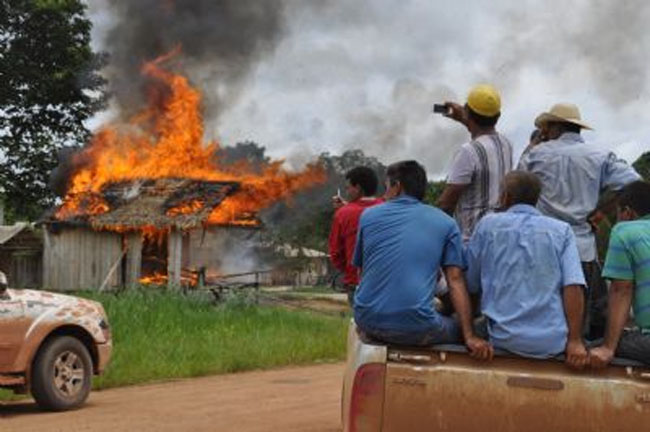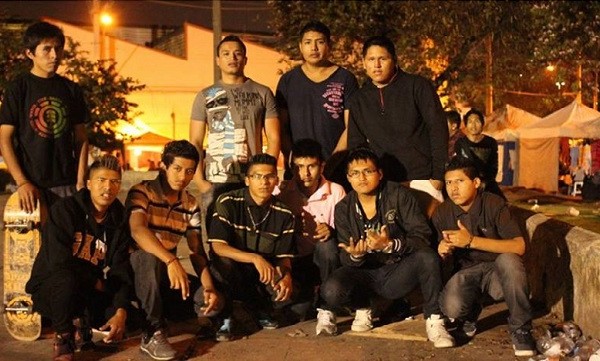Recent news about the conflicts in the Southern Amazonas state, Brazil, by Elaíze Farias @elaizefarias. #Tenharim / Notícias recentes sobre conflito em #Humaitá, Amazonas, por Elaíze Farias @elaizefarias. #Tenharim
Troops of the Federal Police arrived yesterday (27) in Humaitá. There
were two meetings - one in the Town Hall and other in the Army barracks.
The Tenharim Indians refugees in the barracks were not invited to
participate in the meetings.
Tropas da Polícia Federal chegaram ontem (27) a Humaitá. Houve duas reuniões – uma na prefeitura e outra no quartel do Exército. Os indígenas tenharim que estão refugiados no quartel não foram convidados para participar das reuniões.
Tropas da Polícia Federal chegaram ontem (27) a Humaitá. Houve duas reuniões – uma na prefeitura e outra no quartel do Exército. Os indígenas tenharim que estão refugiados no quartel não foram convidados para participar das reuniões.
Ivanildo Tenharim told me last Saturday that the Indians do not know
clearly what actions are being planned and executed in yesterday’s
conflict area, when hundreds of people made an anti-indigenous protest
on the Transamazonic road, more specifically in the area where there
were invasions of villages and fire in the toll base where Tenharim
charge the road use. What is known is that the troops would enter into
the Indian territory to "do a search" of the missing men (or their
bodies) in the villages, since there is suspicion that Tenharim Indians
would have killed these three people (which they deny).
Ivanildo Tenharim me disse neste sábado que os indígenas não sabem com clareza que ações estão sendo planejadas e executadas na área do conflito de ontem, quando centenas de pessoas fizeram um protesto anti-indígena na rodovia Transamazônica, mais especificamente na região onde houve invasões das aldeias e incêndios da base da cobrança do pedágio que os tenharim cobram na estrada. O que se sabe é que as tropas entrariam em território indígena para “fazer uma busca” dos homens desaparecidos (ou seus corpos) nas aldeias, já que há suspeita de que indígenas tenharim teriam matado estas três pessoas (o que eles negam).
Ivanildo Tenharim me disse neste sábado que os indígenas não sabem com clareza que ações estão sendo planejadas e executadas na área do conflito de ontem, quando centenas de pessoas fizeram um protesto anti-indígena na rodovia Transamazônica, mais especificamente na região onde houve invasões das aldeias e incêndios da base da cobrança do pedágio que os tenharim cobram na estrada. O que se sabe é que as tropas entrariam em território indígena para “fazer uma busca” dos homens desaparecidos (ou seus corpos) nas aldeias, já que há suspeita de que indígenas tenharim teriam matado estas três pessoas (o que eles negam).
The other concern is the persistence of Indian people in the barracks.
There is no prevision about the leaving of the 140 Indians from the
place. The Tenharim are awaiting a response from Funai to resolve the
case. In addition to these informations which we summarized here,
Ivanildo gave me the following account:
A outra preocupação é com a permanência dos indígenas no quartel. Não há previsão de saída dos 140 indígenas do local. Os tenharim aguardam uma resposta da Funai para solucionar o caso. Além destas informações que eu resumi aqui, o Ivanildo me deu o seguinte relato:
A outra preocupação é com a permanência dos indígenas no quartel. Não há previsão de saída dos 140 indígenas do local. Os tenharim aguardam uma resposta da Funai para solucionar o caso. Além destas informações que eu resumi aqui, o Ivanildo me deu o seguinte relato:
"They did two meetings, but we did not participate. We just knew that
they did the meetings, no Indians were present. We do not know what they
are doing on the road: If they are going to enter into the village the
village or they are trying to protect the Indians from the farmers’
protests. No Indian leader in the barracks is accompanying the troops at
this time. Now we are waiting for the presence of Funai, that promised
on Saturday to send a team here with us. We are isolated here in the
barracks. We want to leave. It's too bad. It's that way of barracks, all
we want to do we have to ask. We're not used to it. But we still do not
know when we'll get out of here".
“Fizeram duas reuniões, mas não participamos. Só ficamos sabendo que ocorreram e nenhum indígena acompanhou. Não sabemos nem o que eles estão fazendo na rodovia. Se é para entrar na aldeia ou se é para proteger os índios dos protestos dos fazendeiros. Nenhuma liderança que está no quartel acompanha as tropas neste momento. Agora estamos aguardando a presença da Funai, que prometeu enviar uma equipe neste sábado aqui com a gente. Estamos isolados aqui no quartel. A gente quer sair. É muito ruim. É aquele ritmo de quartel, tudo que queremos fazer termos que pedir. Não estamos acostumado com isso. Mas ainda não sabemos quando vamos sair daqui".
“Fizeram duas reuniões, mas não participamos. Só ficamos sabendo que ocorreram e nenhum indígena acompanhou. Não sabemos nem o que eles estão fazendo na rodovia. Se é para entrar na aldeia ou se é para proteger os índios dos protestos dos fazendeiros. Nenhuma liderança que está no quartel acompanha as tropas neste momento. Agora estamos aguardando a presença da Funai, que prometeu enviar uma equipe neste sábado aqui com a gente. Estamos isolados aqui no quartel. A gente quer sair. É muito ruim. É aquele ritmo de quartel, tudo que queremos fazer termos que pedir. Não estamos acostumado com isso. Mas ainda não sabemos quando vamos sair daqui".
See more about this conflict in: / Veja mais sobre este conflito em: Amazonia Real
Source / Fonte: https://www.facebook.com/elaizef/posts/725128257497956
Source / Fonte: https://www.facebook.com/elaizef/posts/725128257497956




